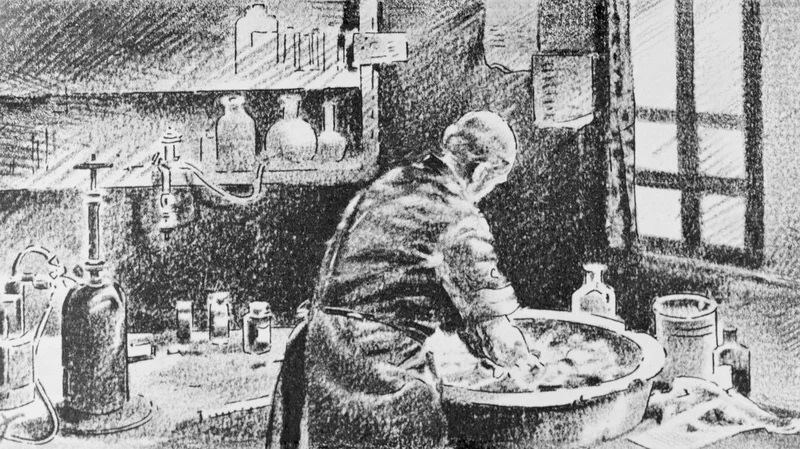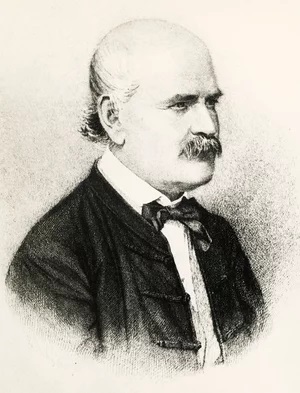Ignorance is a disease. And no story will prove this better than what happened to Ignaz Semmelweis. While we’ve seen many people lose their lives for standing up for the truth, the story of Semmelweis is peculiar in many ways. Baffling, if you’d like to put it that way. But in hindsight, it was all down to ignorance. Or stupidity.
Why was Ignaz Semmelweis murdered simply for speaking the truth? He could have saved many lives. Considering how many people died at that time due to diseases caused by germs, many people, especially mothers and their babies, would’ve stayed alive. If only they listened to him. But he was killed. This is the story of Ignaz Semmelweis, the man beaten to death for promoting handwashing.

Read: How Does Oral Health Affect Overall Wellness?
Who Was Ignaz Semmelweis?
Ignaz Semmelweis was a Hungarian doctor best known for promoting handwashing to prevent the spread of disease. He is considered one of the most important figures in the history of medicine.
Semmelweis was working at a hospital in Vienna in the 1840s when he observed that the number of women dying from childbed fever was significantly higher than the number of men dying from the same disease. He reasoned that the difference was because women were more likely to be treated by doctors who had just come from the dissecting room, where they had been working with cadavers.
So, he suggested that the doctors wash their hands after working with the cadavers. And the number of deaths from childbed fever dropped dramatically. However, his work was met with skepticism and hostility from the medical community. The result? He was eventually beaten to death. Some accounts say he was beaten by a mob of doctors/medical staff. Others say he was beaten by guards.

A Quick Look Into Ignaz Semmelweis’ Life
Ignaz Semmelweis was born on July 1, 1818, in the Austrian Empire’s Kingdom of Hungary in the Tabán neighborhood of Buda (now a part of Budapest, Hungary). He was one of the ten children born to József Semmelweis and Teréz Müller, who had a successful grocery store.
His mother was an ethnic German from Buda, while his father was an ethnic German born in Kismarton. Both towns were in the Kingdom of Hungary. In the same year that he received citizenship in Buda (1806), he also started a wholesale firm selling products for everyday consumption. The business was based at Budapest’s Meindl House, which is now home to the Semmelweis Museum of Medical History at 1-3 Apród Street, and was known as Zum weißen Elefanten. He married Teréz Müller, the daughter of coachbuilder Fülöp Müller, in 1810.
Innovative Tech Solutions, Tailored for You
Our leading tech firm crafts custom software, web & mobile apps, designed with your unique needs in mind. Elevate your business with cutting-edge solutions no one else can offer.
Start NowThe Big Discovery
Ignaz Semmelweis oversaw the maternity unit of Vienna, Austria’s largest hospital, the Allgemeine Krankenhaus, at the time. And six out of every ten women at Semmelweis’ hospital passed away from fever after giving birth. Nothing changed in the symptoms. The new mother would experience chills immediately after giving birth, followed by a fever a few hours later. Afterward, her abdomen would swell and hurt like hell. Within a few days, she would pass away, leaving the world with a child without a mother.
Semmelweis, as the head of the maternity ward, decided to conduct research into the causes of the high death rates. Why not? The incidence occurred so frequently in the hospitals in Vienna.
A medical student-managed clinic for pregnant women had a death rate from a puerperal fever significantly higher than clinics run by midwives. In fact, three times higher, according to the doctor’s research.
Semmelweis’ investigation led him to another discovery: the pregnant women the students later examined had been exposed to “something” the students had brought with them from the mortuary where they had performed an autopsy on the deceased. When they unwrapped the bodies, the doctors and their medical students were met with a potent odor that made the freshmen students quickly throw up. They would then see the uterus, fallopian tubes, and ovaries enlarged and inflamed. This also included pools of puss all throughout the abdominal cavity. All of these no doubt contributed to the transfer of diseases that led to several deaths.

Cadaverous Poisoning Theory
After his close friend Jakob Kolletschka passed away in 1847 from being accidentally stabbed with a student’s knife while doing a postmortem examination, Semmelweis made a significant discovery. An autopsy of Kolletschka revealed a pathology that matched the puerperal fever-related deaths of the women.
Semmelweis promptly proposed a link between cadaveric contamination and puerperal fever. He suggested that he and the medical students apply “cadaverous particles” from the autopsy room to the patients they examined in the First Obstetrical Clinic using their hands. This explains why the Second Clinic’s student midwives, who were not involved in autopsies and had no contact with corpses, observed a significantly lower mortality rate.
Read: Navigating Food Allergies and Intolerances
The Ignaz Semmelweis Order That Saved Lives
The good thing is Ignaz Semmelweis took an immediate step following his discovery. He mandated all of the medical professionals and trainees that worked under him to wash their hands with the chlorinated lime solution prior to entering the delivery room.
He was right.
The death rate dropped from 18% to 1% following the implementation of Semmelweis’ order.
He was unaware of the cause of the success. That’s because, at the time, there was no knowledge of the existence of germs or their ability to spread illnesses. In fact, the germ hypothesis remained unpopular for 18 years. That was until Louis Pasteur, a French biologist, microbiologist, and chemist, made it widely accepted in 1865 with the invention of the pasteurization procedure.
Ignaz Semmelweis provided strong practical proof. But the Vienna medical community’s doctors rejected and disregarded his theory. They refused to consider the possibility, claiming that doing so might harm their patients. Ignaz Semmelweis consequently lost the respect of both his subordinates and superiors, and the entire incident destroyed his career, which he never recovered.

Ignaz Semmelweis’ Career Turmoil
The work of Semmelweis started to gain attention by the end of 1847 in Europe. Several well-known maternity clinic directors received letters from Semmelweis and his students outlining their recent findings. Semmelweis’ finding was publicized in the December 1847 and April 1848 issues of the medical journal edited by Ferdinand von Hebra, a prominent physician in Austria. Ferdinand von Hebra argued that the work of Semmelweis had a similar practical value to Edward Jenner’s invention of cowpox vaccinations to prevent smallpox.
While this was ongoing, one of Semmelweis’ former students wrote a speech outlining Semmelweis’ contributions in late 1848. A review of the lecture appeared in The Lancet, a renowned medical journal, and it was delivered in front of the Royal Medical and Surgical Society in London. Another former student of Semmelweis published a similar essay in a French magazine a few months later.
His Work Was Misunderstood
Semmelweis had reason to believe that the chlorine washings would be widely adopted and save tens of thousands of lives as reports of the sharp decline in mortality rates in Vienna spread throughout Europe.
However, early reactions to his work also clearly indicated impending difficulty. It was obvious that some doctors misunderstood what he was saying. Additionally, early critiques of Semmelweis’ discoveries sought to reduce their importance by asserting that he had not revealed anything novel. But Semmelweis was cautioning against all decomposing organic matter. He wasn’t just warning against a particular infection that came from childbed fever patients themselves.
This error—as well as others like it—occurred in part because Semmelweis’s work was only known through rumors circulated by his associates and students. Semmelweis himself had not written anything at this critical time. Throughout the century, debates about his work were tainted by these and other interpretation errors. However, some sources also emphasize Semmelweis’ reluctance to make his method known to Vienna’s intellectual community. Or to write an explanation of it. This led to speculation that eventually brought about his gruesome death.

Ignaz Semmelweis’ Death and Legacy
Through his hand disinfection practices, Ignaz Semmelweis battled for years to publicize his groundbreaking contribution to the medical hygiene field. After experiencing a mental breakdown, Semmelweis was checked into an asylum by 1865. Shortly after, at the age of 47, he had a hand wound that became infected and caused sepsis.
Seamless API Connectivity for Next-Level Integration
Unlock limitless possibilities by connecting your systems with a custom API built to perform flawlessly. Stand apart with our solutions that others simply can’t offer.
Get StartedHowever, there are many different theories about what happened to the doctor toward the end of his life. From the notion that the rejection he encountered within the medical community may have contributed to his mental decline to the belief that he had early-onset dementia. While in the asylum, he was beaten by the guards and unfortunately died from his injuries. He was still 47 at the time.
Semmelweis’ work was finally acknowledged decades after his passing. This was following the advent of the germ theory of disease and additional developments in the antiseptics industry. Although Semmelweis’ contributions to the idea of germs are honored by numerous monuments and landmarks, including a university, he did not survive to witness the results of his life’s work.
Before you go…
Hey, thank you for reading this blog to the end. I hope it was helpful. Let me tell you a little bit about Nicholas Idoko Technologies. We help businesses and companies build an online presence by developing web, mobile, desktop, and blockchain applications.
As a company, we work with your budget in developing your ideas and projects beautifully and elegantly as well as participate in the growth of your business. We do a lot of freelance work in various sectors such as blockchain, booking, e-commerce, education, online games, voting, and payments. We provide the needed resources to help clients develop their software packages for their targeted audience. As well as deliver on time and on schedule.
Be sure to contact us if you need our services! We are readily available.










